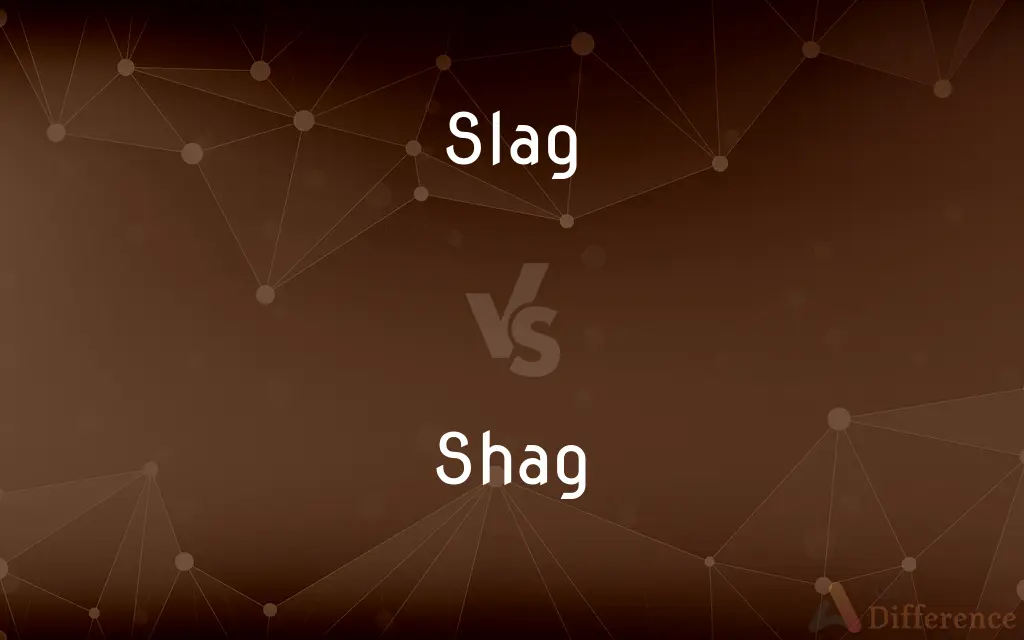Slag vs. Shag — What's the Difference?
By Tayyaba Rehman & Urooj Arif — Updated on April 27, 2024
Slag is a byproduct from smelting ore to extract metal, used in construction, whereas shag refers to either a rough carpet.

Difference Between Slag and Shag
Table of Contents
ADVERTISEMENT
Key Differences
Slag is produced during the smelting process when impurities in metal ores separate and form a stony waste material. Whereas shag can refer to a type of thick, nubby carpet known for its deep pile and soft texture.
In metallurgy, slag helps remove impurities from metals, providing a purer end product. Whereas shag carpets are prized for their aesthetic and comfort qualities in home decor.
Environmental concerns with slag include the disposal of heavy metals it might contain, impacting soil and water. While shag carpets face issues related to cleaning and maintenance, as their deep fibers trap dirt and allergens.
As a recycled product, slag can contribute to sustainable practices in industries by reducing waste. In contrast, shag carpets have evolved in design and materials to include more eco-friendly and hypoallergenic options.
Comparison Chart
Material Properties
Stony, contains metal impurities
Thick, nubby fibers, soft texture
ADVERTISEMENT
Environmental Impact
Potential contamination from heavy metals
Cleaning challenges, allergen retention
Cultural Context
Industrial and construction sectors
Home furnishing and British colloquialism
Compare with Definitions
Slag
A byproduct of the metal smelting process.
The steel industry produces large quantities of slag.
Shag
A thick, soft carpet.
They installed a bright red shag carpet in the lounge.
Slag
Often recycled in environmental reclamation projects.
Slag was utilized to reclaim the old mine site.
Shag
A style of rug with a deep pile.
Shag rugs are difficult to clean due to their deep fibers.
Slag
Waste material containing impurities from ores.
Slag must be disposed of in a safe manner.
Shag
Associated with retro interior designs.
Shag carpets were popular in the 1970s.
Slag
Sometimes used in cement production.
The cement factory incorporated slag to enhance material strength.
Shag
Can be made from various materials.
The new shag carpet is made from recycled plastics.
Slag
A material used in road construction.
They used slag for the base layer of the new highway.
Shag
A tangle or mass, especially of rough matted hair.
Slag
Slag is the glass-like by-product left over after a desired metal has been separated (i.e., smelted) from its raw ore. Slag is usually a mixture of metal oxides and silicon dioxide.
Shag
A coarse long nap, as on a woolen cloth.
Slag
The vitreous mass left as a residue by the smelting of metallic ore.
Shag
Cloth having such a nap.
Slag
See scoria.
Shag
A rug with a thick rough pile.
Slag
To change into or form slag.
Shag
Coarse shredded tobacco.
Slag
Waste material from a mine.
Shag
A dance step of the 1930s consisting of a hop on each foot in turn.
Slag
Scum that forms on the surface of molten metal.
Shag
Any of several cormorants, especially Phalacrocorax aristotelis of Europe and North Africa.
Slag
Impurities formed and separated out when a metal is smelted from ore; vitrified cinders.
Shag
To make shaggy; roughen.
Slag
Hard aggregate remaining as a residue from blast furnaces, sometimes used as a surfacing material.
Shag
To perform or execute this dance.
Slag
Scoria associated with a volcano.
Shag
To chase and bring back; fetch.
Slag
A coward.
Shag
(Baseball) To chase and catch (fly balls) in practice.
Slag
A contemptible person, a scumbag.
Shag
Matted material; rough massed hair, fibres etc.
Slag
A prostitute, or a woman who acts like one; a slut.
Shag
Coarse shredded tobacco.
Slag
(transitive) To produce slag.
Shag
A type of rough carpet pile.
Slag
(intransitive) To become slag; to agglomerate when heated below the fusion point.
Shag
Bacon or fat, especially if with some remaining hair or bristles.
Slag
(transitive) To reduce to slag.
Shag
A roughly-cut or torn-off piece of bread or cheese.
Slag
To talk badly about; to malign or denigrate (someone).
Shag
A deliberately messy, shaggy hairstyle.
Slag
To spit.
Shag
Any of several species of sea birds in the family Phalacrocoracidae (cormorant family), especially the common shag or European shag, Phalacrocorax aristotelis, found on European and African coasts.
Slag
The dross, or recrement, of a metal; also, vitrified cinders.
Shag
A swing dance.
Slag
The scoria of a volcano.
Shag
(northwestern Ontario) A fundraising dance in honour of a couple engaged to be married.
Slag
A product of smelting, containing, mostly as silicates, the substances not sought to be produced as matte or metal, and having a lower specific gravity than the latter; - called also, esp. in iron smelting, cinder. The slag of iron blast furnaces is essentially silicate of calcium, magnesium, and aluminium; that of lead and copper smelting furnaces contains iron.
Shag
(West Country) Friend; mate; buddy.
Slag
To form, or form into, a slag; to agglomerate when heated below the fusion point.
Shag
(transitive) To make hairy or shaggy; to roughen.
Slag
The scum formed by oxidation at the surface of molten metals
Shag
To hang in shaggy clusters.
Shag
(intransitive) To shake, wiggle around.
Shag
To masturbate.
Shag
To chase after; especially, to chase after and return (a ball) hit usually out of play.
Shag
To perform the dance called the shag.
Shag
(obsolete) Hairy; shaggy.
Shag
Coarse hair or nap; rough, woolly hair.
True Witney broadcloth, with its shag unshorn.
Shag
A kind of cloth having a long, coarse nap.
Shag
A kind of prepared tobacco cut fine.
Shag
Any species of cormorant.
Shag
Hairy; shaggy.
Shag
To make hairy or shaggy; hence, to make rough.
Shag the green zone that bounds the boreal skies.
Shag
A strong coarse tobacco that has been shredded
Shag
A matted tangle of hair or fiber;
The dog's woolly shag
Shag
A fabric with long coarse nap;
He bought a shag rug
Shag
A lively dance step consisting of hopping on each foot in turn
Shag
Dance the shag
Common Curiosities
Can slag be recycled?
Yes, slag can be recycled in various industrial applications, including road construction.
Is shag carpet still popular?
Shag carpet has seen a resurgence in popularity, especially in retro and eclectic interior designs.
Are there environmental concerns associated with slag?
Yes, there are concerns regarding the heavy metals slag may contain, which could affect the environment.
Why choose shag carpet for home decor?
Shag carpet is chosen for its comfort, aesthetic appeal, and texture that adds depth to room decor.
What is the difference between slag and ash?
Slag is a stony byproduct of metal smelting, while ash is the residue left from the burning of organic materials.
How sustainable is using slag in construction?
Using slag in construction is considered sustainable as it recycles industrial waste and reduces landfill usage.
What is slag used for?
Slag is primarily used in construction and as a component in cement.
What materials are in slag?
Slag contains various metal impurities and other elements separated from ore during smelting.
What types of shag carpets are there?
Shag carpets can vary in fiber length, material, and design, ranging from traditional wool to modern synthetics.
Is shag carpet expensive?
The cost of shag carpet varies, but it can be more expensive than standard carpets due to its thick pile and material quality.
What era is shag carpet associated with?
Shag carpet is most famously associated with the 1970s era in interior design.
Can slag be harmful?
Slag can be harmful if not handled properly due to the heavy metals it may contain.
How do you clean a shag carpet?
Cleaning a shag carpet typically requires a vacuum with strong suction and possibly professional cleaning services for deep cleaning.
How is slag formed?
Slag is formed when impurities in metal ores melt and separate during the smelting process.
Share Your Discovery

Previous Comparison
Apogee vs. Apoapsis
Next Comparison
Shape vs. ContourAuthor Spotlight
Written by
Tayyaba RehmanTayyaba Rehman is a distinguished writer, currently serving as a primary contributor to askdifference.com. As a researcher in semantics and etymology, Tayyaba's passion for the complexity of languages and their distinctions has found a perfect home on the platform. Tayyaba delves into the intricacies of language, distinguishing between commonly confused words and phrases, thereby providing clarity for readers worldwide.
Co-written by
Urooj ArifUrooj is a skilled content writer at Ask Difference, known for her exceptional ability to simplify complex topics into engaging and informative content. With a passion for research and a flair for clear, concise writing, she consistently delivers articles that resonate with our diverse audience.
















































